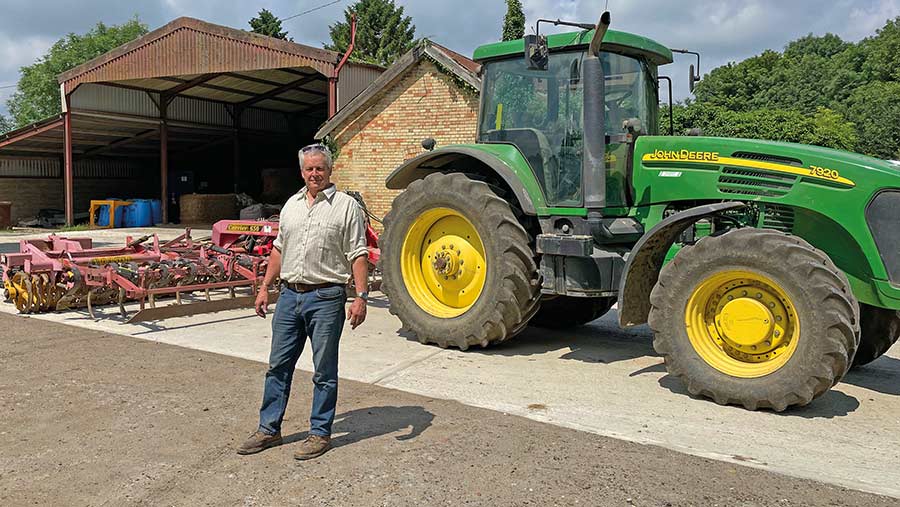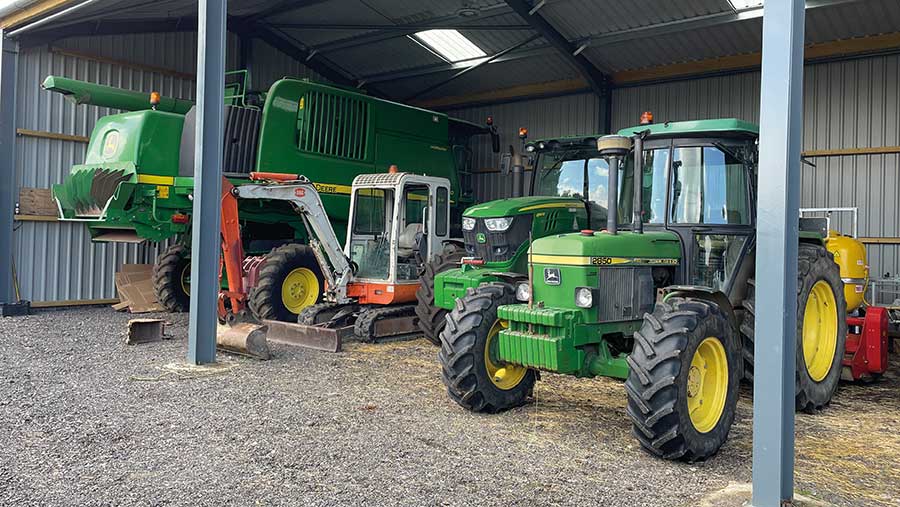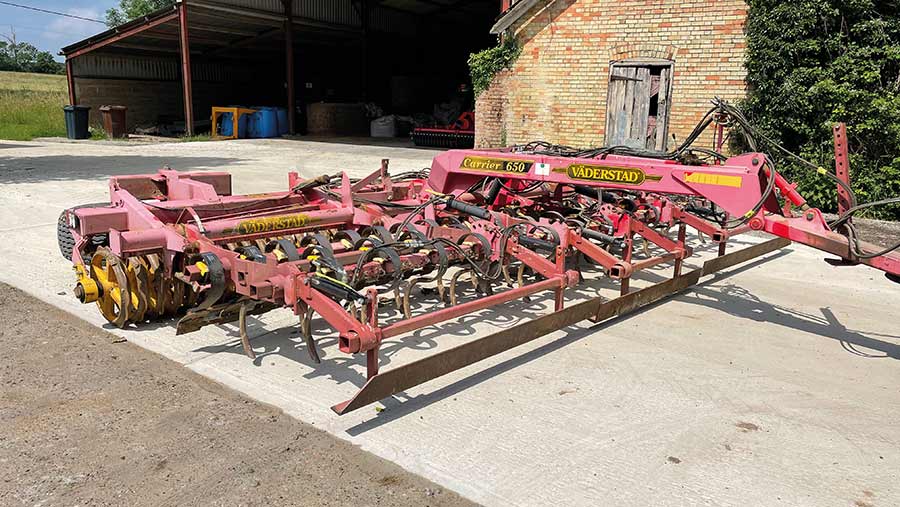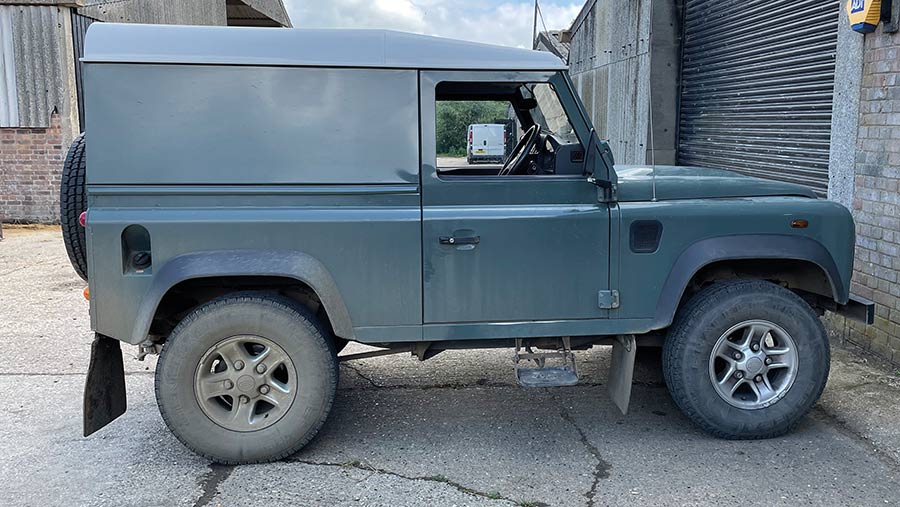What’s in Your Shed? visits a Suffolk arable farm
 © James Andrews
© James Andrews What’s in Your Shed heads to Suffolk to take a look at David Wreathall’s machinery fleet and his collection of modified soil-moving kit.
How did you get started?
The family moved to this 30ha farm in 1960 and in 1989 my Dad and I started contract farming another 200ha.
What cultivation equipment do you use?
I’m not a fan of new pieces of kit that are designed to do an OK job in all soils. Instead, I prefer to buy cheap second-hand machines and modify them so that they perform well on our soils.
As they don’t cost much, I can also justify having several different options to suit the conditions in a particular season.
Most of it has been modified by agricultural engineer Jim Tarry of JTS Machinery, who has a workshop on the farm and specialises in cultivation kit.
He built my primary cultivator, which started out as a 3m McConnel Shakaerator and was fitted with a set of Simba Cultipress tines and a twin row of 660mm Gregoire Besson-style ridged discs.
This does a great job of opening the ground when it’s tight.
If the ground doesn’t need loosening at depth, I use a 6m set of Massey Ferguson pigtail tines with spring tines at the rear.
These work up a decent amount of soil without bringing more clods to the surface for us to break down. They’re also handy for levelling ploughed ground.
See also: Bespoke Stripcat drill expands companion cropping options
Farm facts: Banstead Farm, Newmarket, Suffolk
- Size 230ha, some owned and the rest contract-farmed
- Crops grown Winter wheat, winter and spring barley, oilseed rape, winter linseed, spring beans
- Soil type Medium loam
- Staff David, plus family and friends in peak season
Depending on the conditions, the primary cultivators are followed by a Simba Cultipress or a Vaderstad Carrier 650, both of which have been modified.
The Cultipress now has a set of hydraulic levelling boards on the front, which has transformed it.
They bash clods and take out all the lumps and bumps, giving a fine, even finish – it comes into its own in a dry year.
The Carrier also has levelling boards on the front, and the second set of paddles have had a length of flat steel welded across to make them more aggressive.
It started out life with system discs, but we changed it to tines which work much better on our soil.
I’ve also got a 6m Kongskilde Triple K tine cultivator with a home-made following harrow.
How brand loyal are you?
I’ve been very loyal to John Deere over the years as I like the machines and they’ve always been reliable.
The first tractor was a 2130 two-wheel-drive that we got in the 1970s from the local dealer at the time, Blyth and Pawsey.
It was a great machine and we moved away from Ford as a result.
The only non-green tractors we’ve had since were a Massey Ferguson 2640 and 2725, which were solid and robust. However, they weren’t very comfortable to drive and had a few niggly problems.

© James Andrews
Favourite dealer?
I don’t buy much new equipment, but I get parts and the odd used machine from Ben Burgess, Thurlow Nunn Standen, Brocks and Agri-Linc.
I’ve always found Derry Morton at Agri-Linc particularly nice to deal with.
Best tractor you’ve ever had?
It’s probably the John Deere 7800 Power Quad that we bought second-hand in the 1990s when it had done just under 1,000 hours.
The engine was lovely, it pulled hard and it didn’t give any trouble, apart from the injectors.
The only downside was the bumpy ride on the road, which we used to calm down by dropping the tyre pressures. We sold it in 2005 when it was on 4,000 hours and replaced it with the 7920, which I bought new.
The 7920 is also well up there, as it’s a lot nicer to drive than the 7800 and has plenty of old-fashioned grunt.
It had to have the Autopowr transmission pump changed, though, which set me back more than £5,000.
Worst tractor you’ve ever had?
I’m lucky that I’ve never had a really bad one. The Massey 2640 and 2725 were probably the most troublesome, but they were minor problems that didn’t stop us for long.
From a driver’s point of view, the County 1124 we used to have with a Lambourn cab was by far the most unpleasant to drive. It used to rattle your head off and the turning circle was appalling.
Favourite machine?
The John Deere T550 Hillmaster combine, as it’s such a nice relaxing machine to drive.
Deere really knows how to make a comfortable cab – it’s quiet, is fitted with excellent climate control, and it has autosteer guidance that means I don’t even have to concentrate on driving straight.
It also produces an excellent sample, and as it’s a walker machine it keeps the straw in good condition, which is important as we bale most of it.
A few people ribbed me for getting a Hillmaster in Suffolk, but even though I’m not in a particularly hilly area, there are some slopes on the farm that max out its articulation.
Favourite and least favourite job?
Drilling is my favourite, and I’ve often said I’d do it for free if I had to. Cleaning out the grain bins is the worst and always requires a concerted effort to make a start.
In the shed
- Tractors John Deere 7920, 6150R, 6920S and 2850
- Cultivation kit Custom 3m primary cultivator, modified Vaderstad Carrier 650, Simba Cultipress with front levelling board, 6m Massey Ferguson pigtail cultivator with spring tines at rear, 6m Kongskilde Triple K with following harrow, Simba 7.6m Cambridge rolls, Lemken six-furrow plough, 3m Kuhn power-harrow
- Drills 6m Weaving tine drill, 4m Accord combination, He-Va Disc Roller converted to a cover crop drill
- Sprayer Househam Air Ride with 3,000-litre tank and 24m boom
- Telehander JCB Loadall 530-70
- Combine John Deere T550 Hillmaster with 20ft header
How long do you keep your machines?
I don’t have any set plans for changing machinery, but I do tend to move it on before it gets to high hour counts. That said, I don’t do many hours in a year, so the tractors I’ve got now will probably see me out.
Do you buy second-hand?
Most of my machinery is second-hand and the last time I bought a new tractor was the 7920 in 2005.
The newest tractor I have is a 6150R that I bought second-hand from Ben Burgess. I wasn’t in the market at the time, but it was lovely tractor – one of the last before AdBlue came in – and the deal seemed good.
I enjoy driving it, but I’m wary of the fact that it’s got so many electronics.

© James Andrews
Oldest machine still at work?
The 6m Massey Ferguson pigtail cultivator that we’ve modified by adding a set of spring tines on the rear.
However, the oldest machine with an engine is a 2001 JCB Loadall 530-70 that I bought to replace one that burnt out after a hydraulic pipe burst and sprayed hot oil onto the exhaust.
It’s done 5,800 hours and, other than the odd electrical problem, it’s gone well.
Latest purchase?
The Vaderstad Carrier 650 is my most recent machine, and I bought that about two years ago. It was a very worn system disc model and Jim Tarry at JTS Machinery helped me convert it to tines, replace the worn rings and add some levelling boards.

© James Andrews
I don’t rate the disc models, but this version has become my most versatile secondary cultivator.
It will create a decent seed-bed in most conditions and as it’s more than 6m wide we can cover the ground in no time.
It gets pulled by the 7920 and we run it at about 8kph; any faster than that and it throws the soil around too much.
All in, it cost about £12,000 and it’s a seriously good machine for the money.
What’s next on your wishlist?
I’ve got a couple of drills in the pipeline. The first is a bean drill that’s going to be based on an old prototype frame I picked up.
This will have a hopper and metering system mounted on the top and a set of C-tine coulters with home-made seeding boots.
For the second, I’m looking to mount a small seed applicator on the top of my 3m Kuhn power-harrow, which will be used for establishing wild bird seed mixes into a decent seed-bed.
It should complement the modified He-Va disc roller that I’ve got for direct seeding cover crops such as mustard directly into stubbles.
Best workshop tool?
I bought my first pillar drill a little while ago and I don’t know how I managed without one. It’s a fairly simple Truecraft model from Spaldings, but it is accurate and far quicker than drilling by hand.
It really came into its own when we made a following harrow for the Triple K cultivator and needed to drill a series of holes for bolting on the tines.
What’s your biggest mistake?
I was hedgecutting on a wet day with the windows misted up and I whacked the boom into an oak tree.
There was enough force to bring a big branch down, which smashed the tractor roof and mudguard and broke the cooling fan on the trimmer.
Most expensive repair bill?
The hedgecutter incident was the biggest bill at £8,000, but that was covered by insurance. After that, it would probably be the Autopowr transmission pump on the 7920.
Best invention?
A bolt-on combine auger chute that means we can unload on the move without having to drive on the straw. We used to have a long sock on the end, but it didn’t throw the grain quite far enough.
It’s made from relatively thin sheet steel so that it doesn’t add too much weight and put extra strain on the auger.
Best machinery bargain?
I think the 6920S was my best buy, which I got to replace a standard 6920. I paid £27,000 for it 12 years ago when it was on just 1,300 hours.
It’s a tidy 2006 model and has been an excellent tractor – it won’t be leaving the farm anytime soon.
What’s your everyday transport?
I’ve got a 2009 Land Rover Defender 90, which I love driving, apart from the fact it gives my back some stick. It’s done 105,000 miles and hasn’t given much trouble.
I’ve also got a 2001 single-cab Mitsubishi L200 which just keeps going and usually sails through its MOT – it’s on 85,000 miles.

© James Andrews
